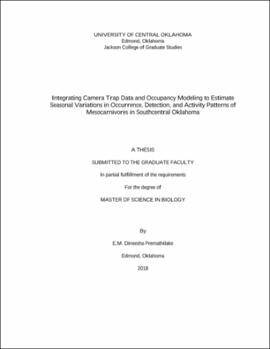| dc.description.abstract | Mesocarnivores have important ecological roles as primary predators of food webs who significantly contribute to maintaining the health of the lower trophic levels. Various anthropogenic effects impact the viability of mesocarnivore populations; therefore, conservation is essential to maintain ecosystem integrity. Camera trapping has been increasingly used to monitor different ecological aspects of wildlife, specifically for elusive, large carnivores. Recently, camera-traps have been used to study temporal species interactions, most often for predator-prey relationships in large carnivores. Relatively few studies have been conducted on spatial ecology and temporal activity overlap between mesocarnivore species using camera-traps, and there are no such studies done in the State of Oklahoma. My study was conducted at Oka' Yanahli Preserve (OYP), located in southcentral Oklahoma. The primary goal of this project was to expand the current body of knowledge about mesocarnivore ecology in southcentral Oklahoma, specifically at OYP. Camera traps were used to capture images of mesocarnivores in the preserve over winter (November 2016 to February 2017) and summer (May to August 2017). Six remotely-triggered infra-red cameras were deployed for 4 weeks. After 4 weeks, cameras were moved to different, random locations. Half of the cameras were systematically baited by using canned mackerel. A total of 2778 mesocarnivore pictures from winter and 1455 from summer were taken from 25 camera locations in winter and 18 camera locations in summer. Species richness, detection frequencies, detectability, and occupancy estimates were determined by analyzing pictures. Mesocarnivore species identified from both seasons were coyote (Canis latrans), raccoon (Procyon lotor), bobcat (Lynx rufus), Virginia opossum (Didelphis virginiana), and striped skunk (Mephitis mephitis). Results show the proportion of sites occupied and detection probabilities were higher for all species during winter than in summer (single species occupancy modeling). Overall detection probability was higher with baited camera traps for raccoon, skunk and opossum (not significantly different) obtained from single species occupancy modeling. Baiting had no overall effect on the probability of detection for all species in summer. A possible reason could be the abundance of food resources were higher during summer than winter; therefore, there was less attraction to the bait around camera sites in summer. Temporal activity densities were higher for all species during winter than in summer (Circular Kernel Density Estimates) and all species were mostly nocturnal during winter whereas in summer coyote and raccoon were often active during the day. Bobcat were strictly nocturnal in both seasons. Temporal activities overlapped largely (?êå>0.7) between all species in winter, except for skunk. The summer had moderate activity overlap for all species (?êå<0.7). There was a significant difference in activity overlap within species, between two seasons (p<0.05). Contradictory to what I expected, the data show that mesocarnivore species present in this preserve do not necessarily avoid each other, rather they co-exist partitioning their resources. Intraguild competition or avoidance could be less expected in this preserve as supported by my results of large temporal overlap between the species. The data gathered from this research will be useful in future research, long-term monitoring efforts, and restoration of habitats of mesocarnivores in OYP. Establishing baseline knowledge of the abundance and species richness of mesocarnivore species is imperative to gain an understanding of how mesocarnivores react to different management strategies, and could be compared to this baseline inventory. In addition, knowing which species inhabit the area may alert property managers to species of conservation concern. | |
